Celebrating Dykes on Mykes (4ZZZ) on International Lesbian Day
By Associate Professor Heather Anderson, 2024 Rainbow Research Fellow | 30 September 2024
This blog was written by 2024 Rainbow Research Fellow, Associate Professor Heather Anderson.
October 8 marks International Lesbian Day, and to celebrate, 2024 Rainbow Research Fellow, Heather Anderson delves deep into the John Oxley Library’s Radio Times collection to explore the rich history of queer femme broadcasting on Queensland’s oldest community radio station, 4ZZZ.
Hold onto your merkins, people—it’s time for the Dykes on Mykes!
This lively introduction kicks off each episode of 4ZZZ’s long-running lesbian and queer women’s radio show, Dykes on Mykes. If you tune in on a Wednesday evening at 6 pm, you’ll hear these words before diving into a two-hour broadcast of queer-femme discussions, stories, and music. Stay tuned after, and the sibling show Queer Radio will take over from 8 pm for more LGBTQ+ voices.
Brisbane’s community radio station 4ZZZ has a long and robust history of queer broadcasting with some claiming 4ZZZ holds the longest-running legacy of LGBTQ+ radio programming worldwide. When the station launched in December 1975, it was Lauren McKinnon’s Gay & Lesbian Radio Collective that made sure gay and lesbian issues were part of the station’s programming. Notably, the first voice heard on 4ZZZ belonged to an announcer who had been fired from Adelaide’s Channel 9 for participating in a Gay Rights demonstration.
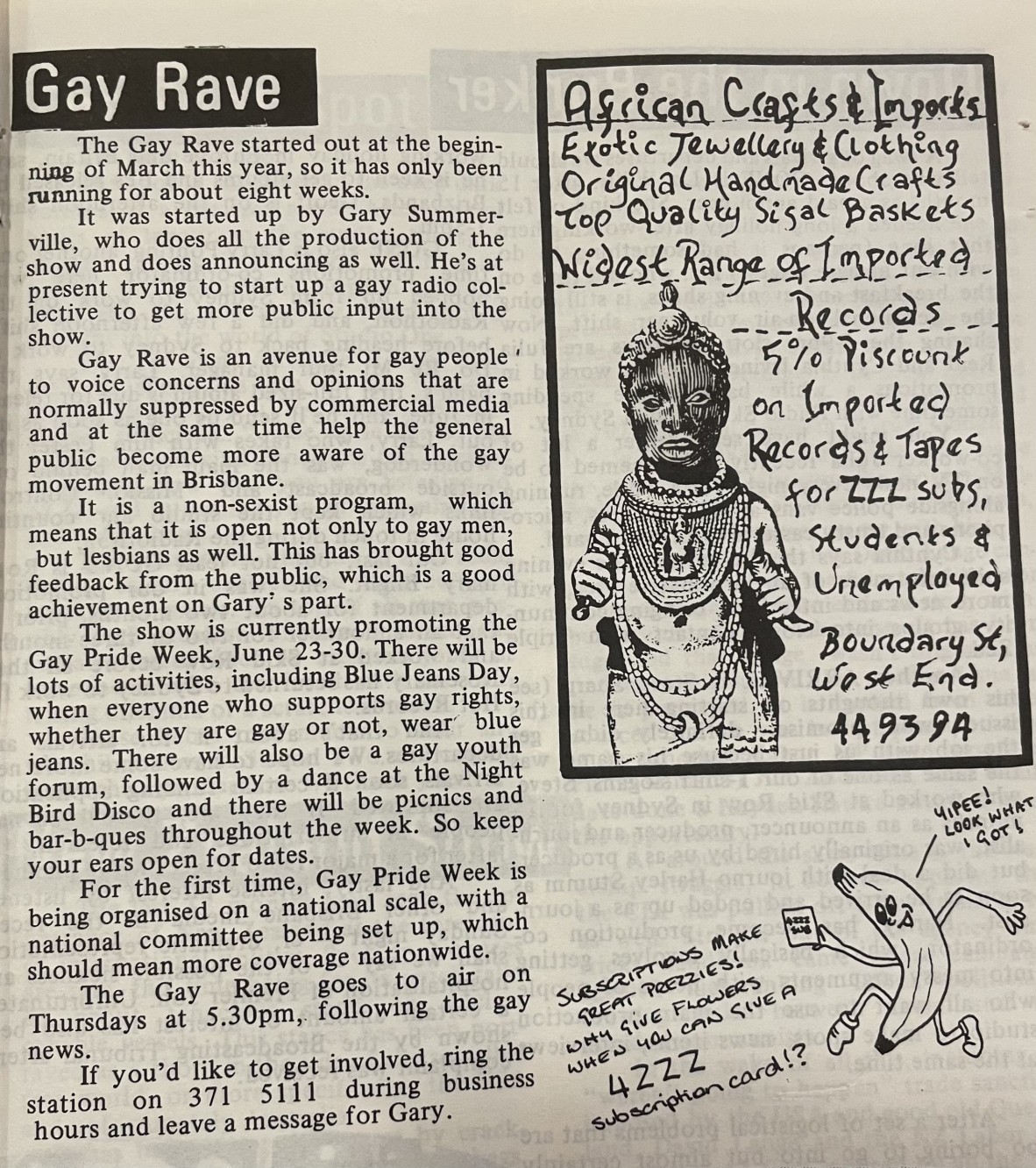
Gay Rave article, Radio Times May 1985, John Oxley Library, State Library of Queensland.
In March 1985, 4ZZZ’s schedule included its first dedicated queer-specific show, Gay Rave, established by Gary Summerville. The program was described, in Radio Times (May ’85), as “a non-sexist program ... open not only to gay men, but lesbians as well” which “has brought good feedback from the public”. Gay Rave originally broadcast at 5.30pm on Thursdays, following what was then simply called “the gay news”. It was a pioneering moment for 4ZZZ, but also one that stirred tensions within the station’s audience, some of whom were still grappling with the inclusion of queer content, as this letter to the editor in Radio Times (Oct ’85) demonstrates:
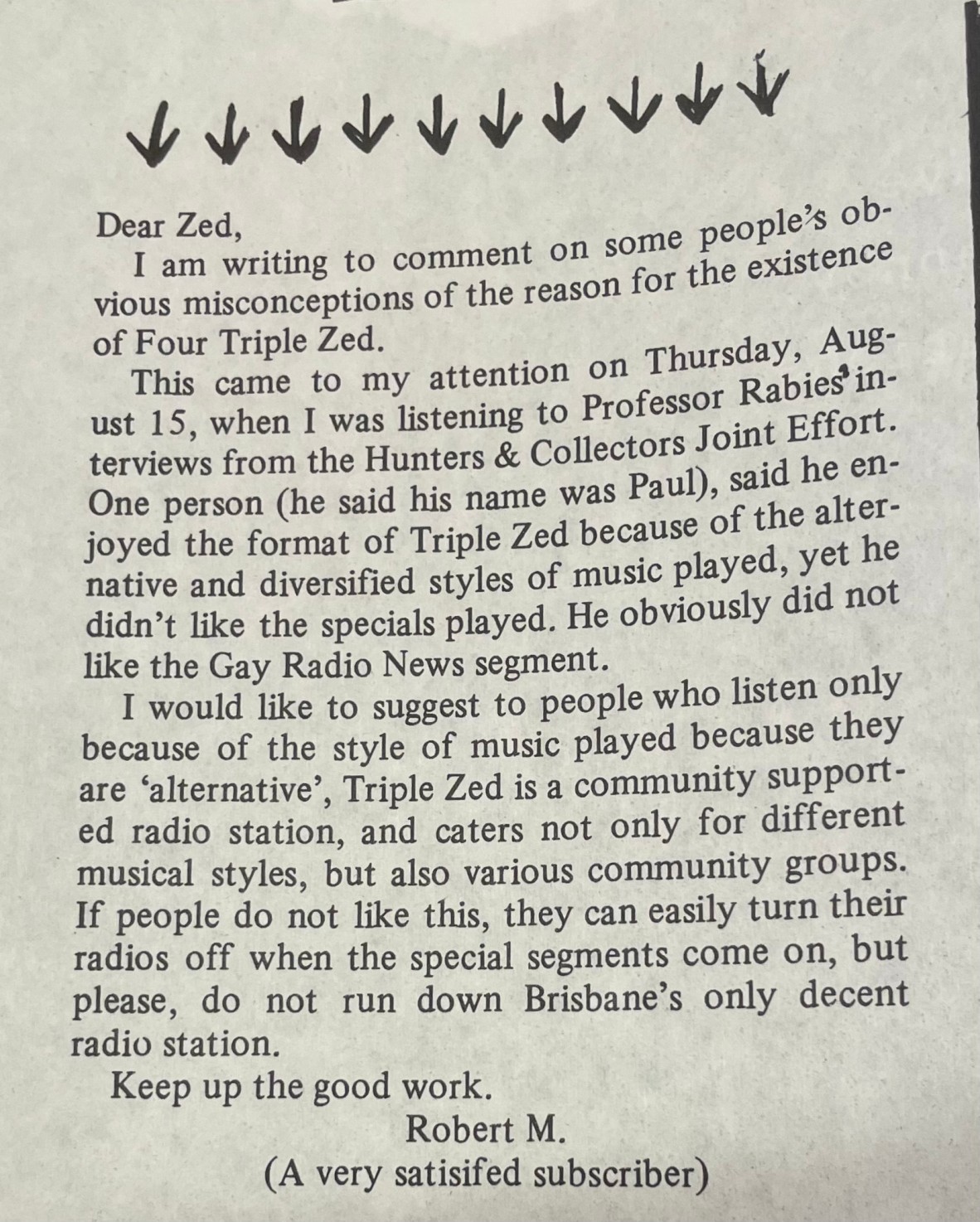
Letter to Editor, Radio Times Oct 1985, John Oxley Library, State Library of Queensland.
By late 1986, Gay Rave had transformed into the more well-remembered Gay Waves (7.30pm Thursdays) – not to be confused with the slightly earlier program of the same name on Sydney community radio station, 2SER. An article in Radio Times (Sept ’86) makes clear that the program intended to cover “topics and news of interests to both lesbians and gay men”. Hosts included Ingrid Tall, Deb Strutt and Toye De Wilde, who would go on to run for a seat in the Merthyr state by-election for the Queensland Legislative Assembly, as the first transgender political candidate in Australia.
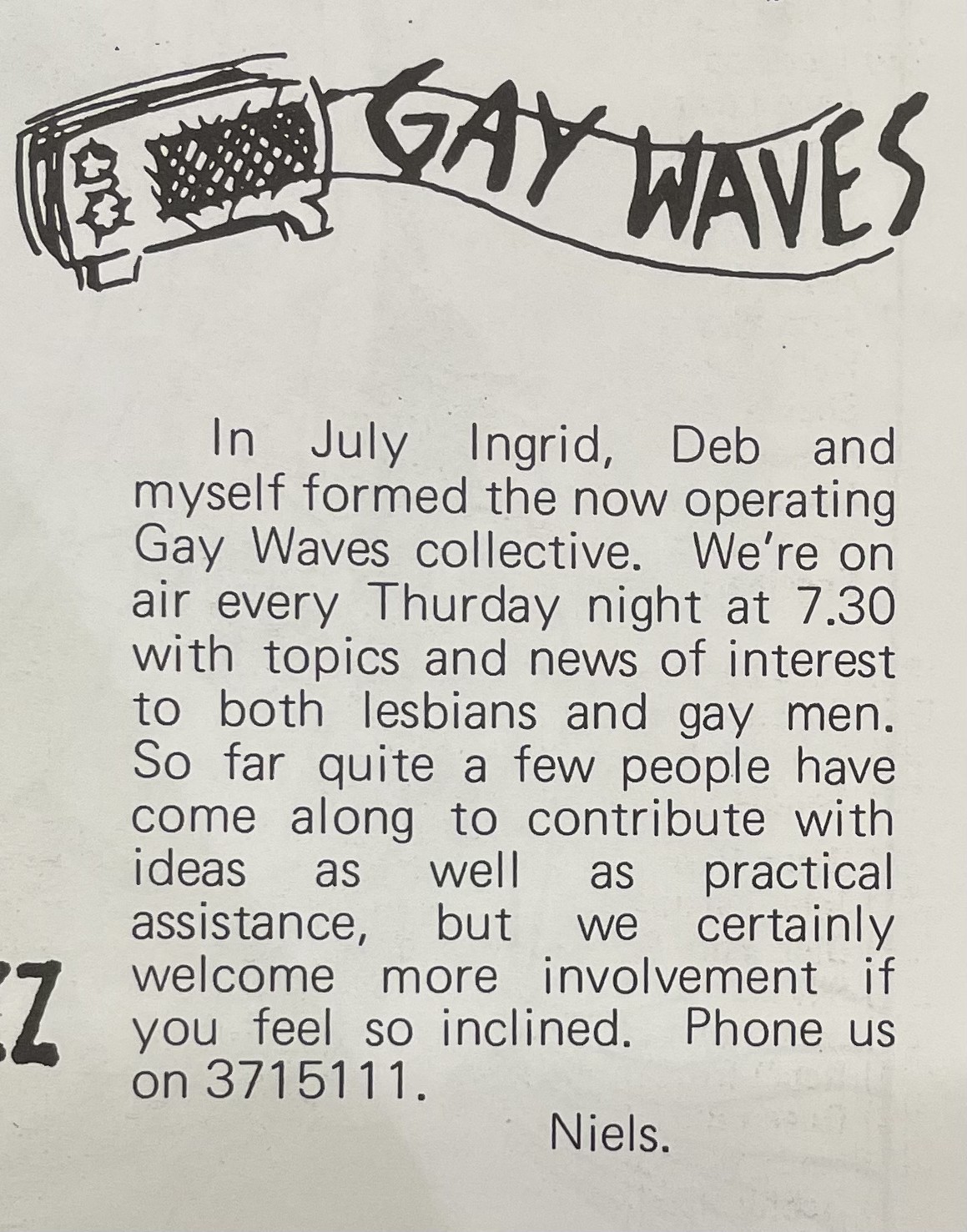
Gay Waves article, Radio Times Sept 1986, John Oxley Library, State Library of Queensland.
Queer broadcasting on 4ZZZ became a crucial lifeline in the 1980s and early 1990s, especially during the AIDS crisis. Homosexuality had only recently been removed from the World Health Organization’s list of classified diseases, and queer folk still faced significant discrimination. For many, the anonymity of radio provided a safe space to explore their identity. As former long-time host Gai Lemon explained to me in a recent interview on 4ZZZ:
If someone walked into the room while you were listening, you could easily switch to another station, unlike leaving a book or magazine lying around, which could out you.

Queer Radio article, Radio Times March 1993, John Oxley Library, State Library of Queensland
By 1993, Gay Waves had split into two shows: Queer Radio and The Lesbian Show. The initial alternating schedule—where The Lesbian Show aired every third week—proved confusing for listeners, so in late 1996, the two shows agreed to simply share the allocated timeslot each week. It was during this time that The Lesbian Show adopted its now-iconic name, Dykes on Mykes, after a fan wrote a letter with that cheeky salutation. As Gai explains:
We used to get handwritten letters from fans and one ... wrote to us one night, she went ‘Dear Dykes on Mykes’ and I said to Deb, one of my co-announcers, ‘Oh my god That's our name!’. And so we just took it and ran with it.
The timing of the name change can be narrowed to between June 1996 and early 1997. The program guide from the ‘Summer of 96/97’ Radio Times includes the Dykes on Mykes show name for the first time, sharing the timeslot with Queer Radio.

Program guide, Radio Times 1996-97 summer edition, John Oxley Library, State Library of Queensland.
In 1999, 4ZZZ officially entered the Sydney Gay and Lesbian Mardi Gras Parade for the first time. According to the February/March 2000 Radio Times, it was “a great profile-raiser for the station as ... a significant part of Australian’s gay and lesbian media”. The 4ZZZ delegate of five women and three men distributed “Assorted Family” biscuits to the crowd and were supported with cheers from “more than a few Zed Heads yell(ing) their support”.
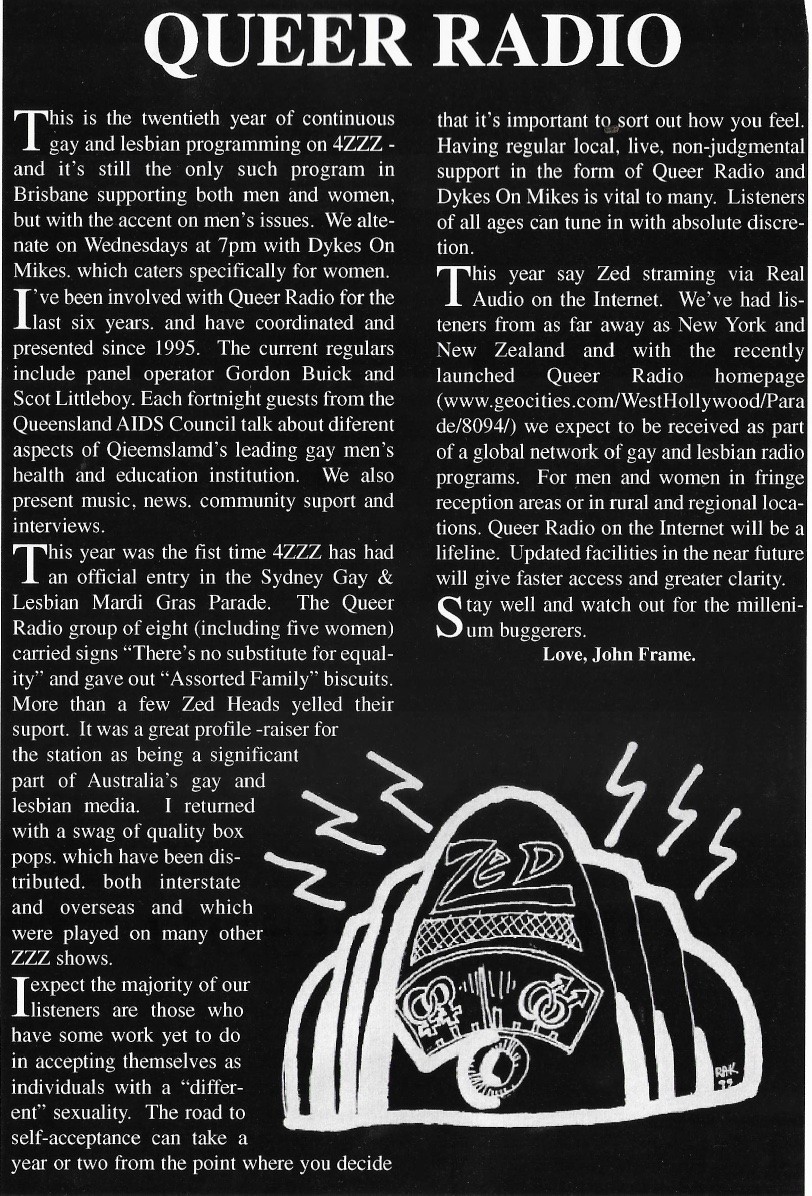
Queer Radio article, Radio Times Feb/Mar 2000, John Oxley Library, State Library of Queensland.
In August 2002 Dykes on Mykes (and Queer Radio) finally secured individual timeslots, when the station allocated each show two-hours a week. This came after extensive lobbying, not so much to separate the programs but to claim more time on the airwaves. Back in 1994, the shared timeslot had been cut from three hours to two (7-9pm Wednesday), which the broadcasters felt was not enough airspace to satisfy the needs of the diverse communities represented through the two programs.
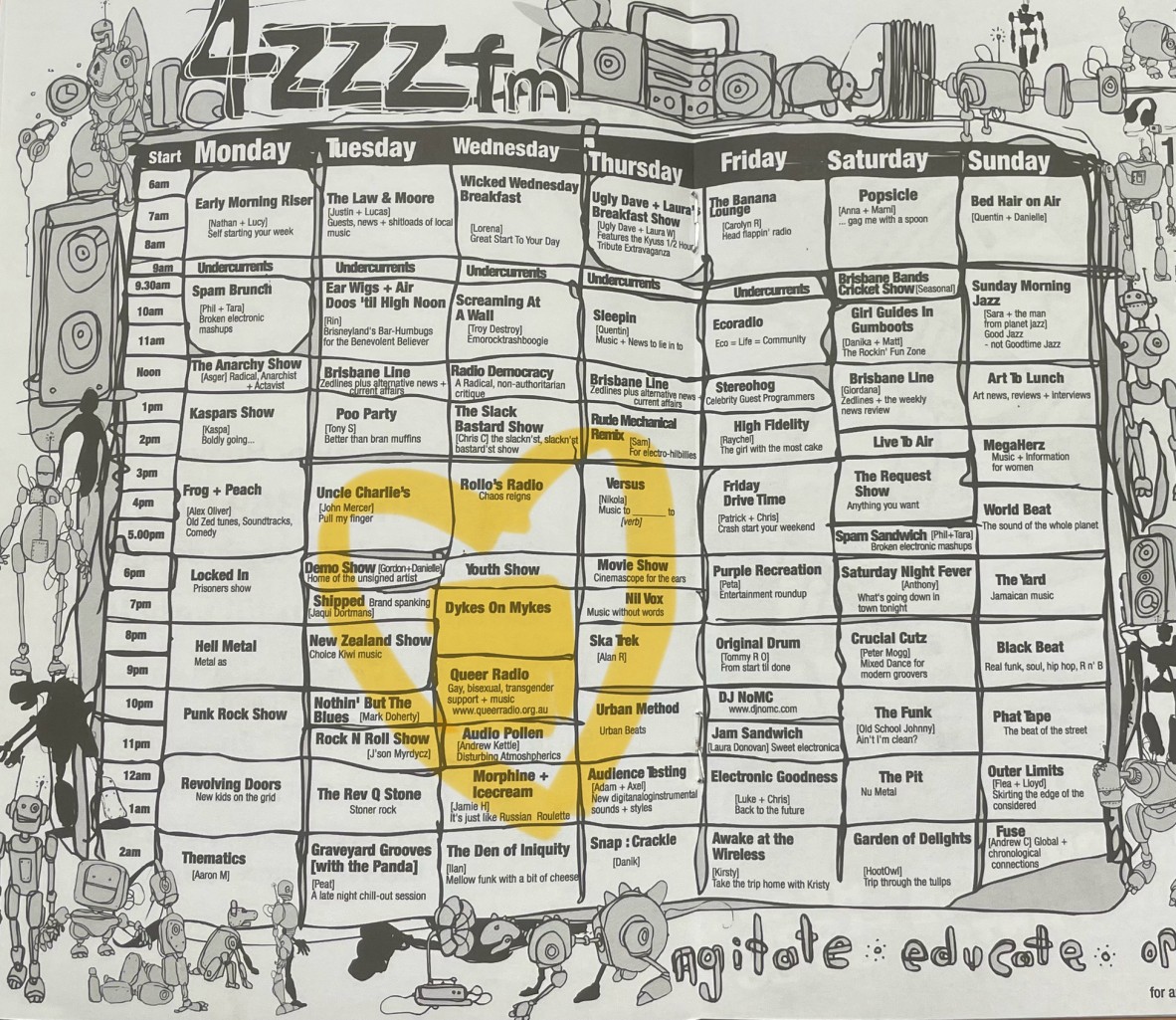
Program guide, Radio Times Oct 2002, John Oxley Library, State Library of Queensland.
Twenty-two years later, Dykes on Mykes is still going strong, broadcasting on 4ZZZ and Melbourne’s Joy-FM, Australia’s only LGBTQI+ community radio station. The show has evolved with the times, moving from a focus on activism and rights for queer people in Queensland to a broader mix of discussions on art, culture, and identity. Longtime presenters Ruth Gardner and Kate Mackie note that while the show’s early days were heavily focused on activism, today, there’s a greater emphasis on creative expression and community support.
However, the activism hasn’t disappeared - it's simply shifted focus. Ruth and Kate reflect that in recent years, the show has turned its attention to trans rights and First Nations issues. The presenters also recognise that simply being on air, reaching a broad audience, is an act of resistance in itself. As Ruth says:
We’ll keep amplifying the voices that need to be brought forward.
Dykes on Mykes has always been about giving a platform to those who need it most. Ruth, now the Chair of 4ZZZ’s Board of Directors, explains:
As long as there are unjust power structures in the world, there will always be people that need to be brought forward.”
4ZZZ’s commitment to marginalised voices extends beyond the queer community, striving to lift all those who are silenced or oppressed. Whether through political rants, artistic conversations, or simply providing a platform for diverse voices, Dykes on Mykes continues to thrive, amplifying the voices of those who need to be heard.
Associate Professor Heather Anderson, 2024 Rainbow Research Fellow.
Other blogs by Heather Anderson
- Finding feminist voices in the early years of Queensland community radio
- Read other blogs by previous Rainbow Research Fellows.
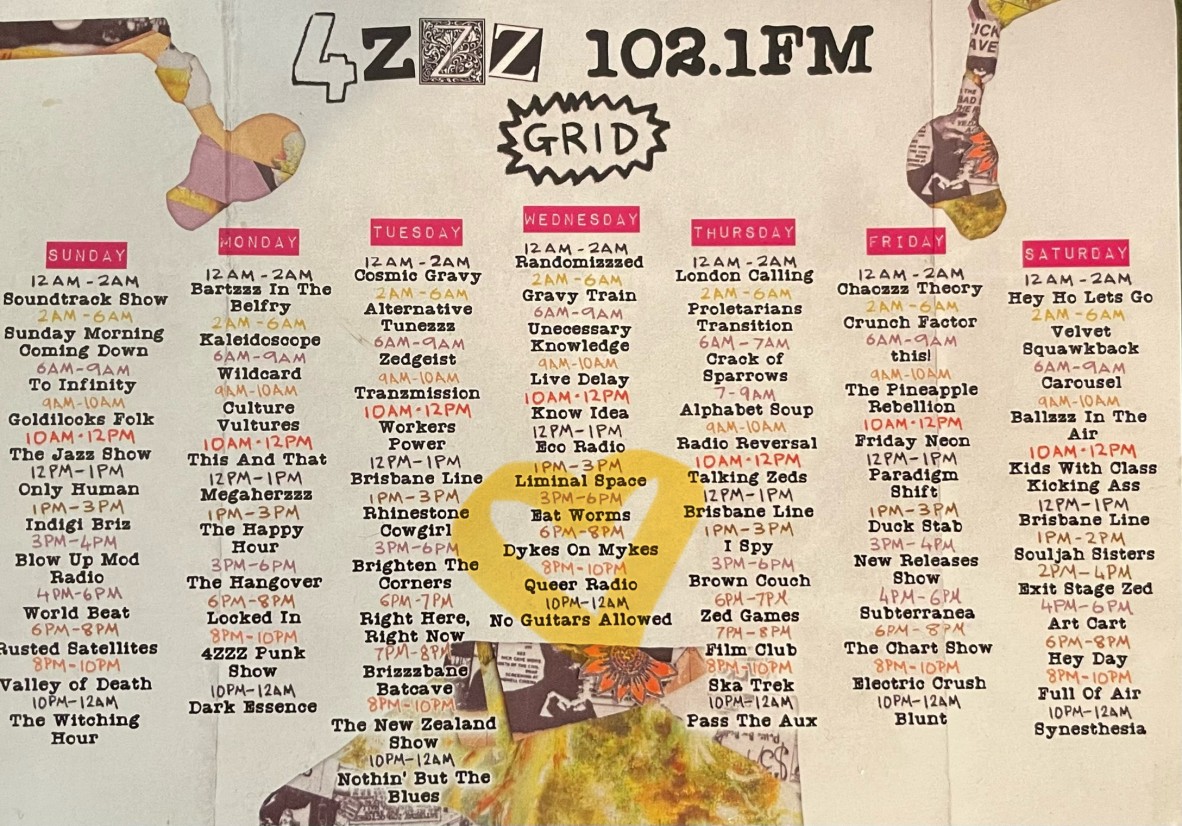
Recent program guide, 4ZZZ
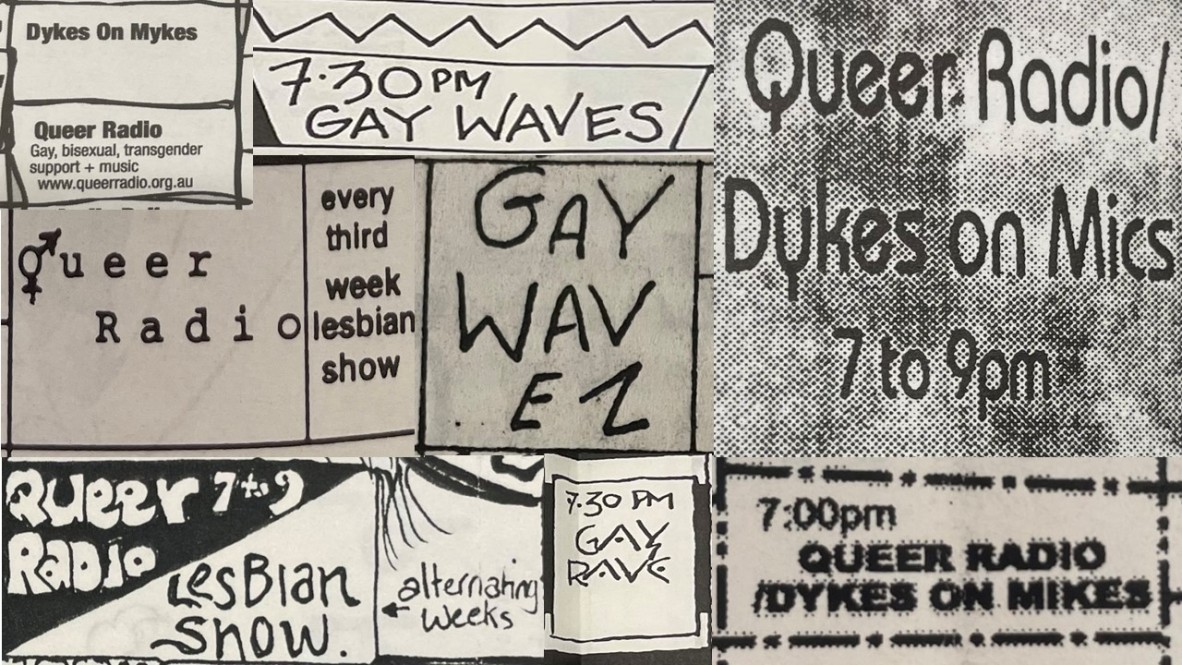
Collage of various program guides 1985 - 2002. Radio Times, John Oxley Library, State Library of Queensland.
Dr Heather Anderson's Research Reveals talk.
Comments
Your email address will not be published.
We welcome relevant, respectful comments.